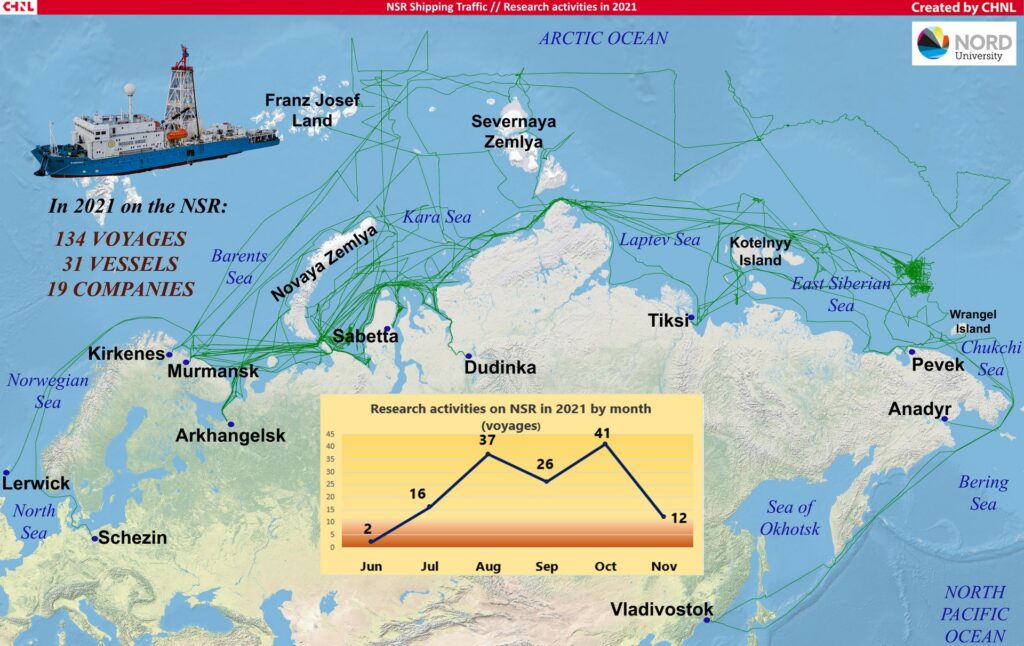NSR Shipping Traffic – Research activities in 2021
In 2021, a large number of research works were carried out. 19 companies involved 21 vessels for research work. In total, there were 134 passages from a port to a work area and back, and this number also included passages from one work area to another. For comparison, in 2020, 116 such transitions were made, 27 vessels from 13 companies operated.
The first entrance to the NSR waters was at the end of June (the vessel Akademik Keldysh, ice class Arc 4), but the peak of work fell on the middle of the summer navigation period – from August to October (see chart on the map). The vessel Mikhail Somov was the last among the research vessels to leave the Arctic seas (the NSR was left on November 28). Such a late return to the home port of Arkhangelsk was due to severe ice conditions that found the ship in the northeastern part of the Kara Sea. Mikhail Somov was not far from Russkiy Island, off the coast of the Taimyr peninsula, away from ship routes, when it first helped by the LNG carrier Boris Davydov. The tanker freed the ship from the ice and continued its voyage to the port of Sabetta, but soon Mikhail Somov got stuck in the ice again. This time another LNG tanker – Rudolf Samoylovich – helped the ship. For three days, the research vessel followed the tanker, after that it continued its journey to Arkhangelsk on its own.
www.rgo.ru
The icebreaker “Dikson” escorted the research vessel “Akademik Primakov” through the Vilkitskiy Strait to open water in the Laptev Sea. On August 16, Dikson started the voyage from the port of Arkhangelsk to provide services under an agreement with Sevmorneftegeofizika (SMNG) for icebreaker support of the vessel Akademik Primakov, which was heading east to carry out work in the area of Wrangel Island. From August 18, the icebreaker escorted the ship in the Kara Sea, on August 20, on the approaches to the Vilkitskiy Strait, she took the ship for pilotage in conditions of first-year ice.
seanews.ru
Like last year, the geography of research work covered all the seas of the Northern Sea Route. Below information on some of the research projects being carried out in this region in 2021.
The research vessel Akademik Treshnikov with scientists from different countries on board, conducted comprehensive scientific research. The work of the international expedition Arktika-2021, was lasted until September 6. Research was carried out in the waters of the Barents and Kara Seas, as well as the Laptev Sea and near some islands. The work was on the initiative of the famous polar explorer Frederik Paulsen, a member of the Board of Trustees of the Russian Geographical Society. This was a joint project of the Arctic and Antarctic Research Institute (AARI) and the Swiss Polar Foundation, aimed at studying the natural environment of the Arctic in a changing climate. The peculiarity of the current expedition lay in the fact that scientists conducted comprehensive research using modern equipment not only in the waters of the northern seas, but also in the coastal part of the Arctic islands. The participants of the international expedition collected data on the distribution of the Atlantic water mass, one of the main sources of heat in the Arctic region. And in the coastal zone, they studied climate and sea level fluctuations to reconstruct the process of glaciation in the Arctic based on the study of coastlines, lakes and glaciers on the islands. In addition to the AARI staff, representatives of the Zoological Institute of the Russian Academy of Sciences (St.Petersburg), A. N. Severtsov Institute of Ecology and Evolution of the Russian Academy of Sciences (Moscow), the Alfred-Wegener Institute for Marine and Polar Research (Bremenhafen, Germany), the Swiss Polar Institute and other scientific organizations took part.
spbvedomosti.ru
A comprehensive environmental expedition to study the environmental situation in the western part of the Northern Sea Route was carried out on the research vessel “Aleksey Maryshev” provided by Hydrographic Enterprise (Rosatom). The expedition was organized by the Marine Research Center of M.V. Lomonosov Moscow State University by order of Rosatom.
The project was aimed at conducting a regular assessment of the environmental consequences of anthropogenic impact during the operation of the Northern Sea Route (including nuclear facilities) on the environment of the Arctic zone. Five employees of the Moscow State University’s Central Research Institute, who were on board the Alexey Maryshev vessel, were exploring the waters of the Ob Bay, the Yenisey Bay and the western part of the Kara Sea. The environmental monitoring program included studies at 50 stations throughout the NSR. The eastern part of the Northern Sea Route was being studied by the employees of the Moscow State University’s Central Research Institute from the board of the Professor Logachev vessel. Based on the work results, a group of Russian and international experts will propose a plan for regular monitoring of the Arctic ecosystems.
portnews.ru
On August 26, 2021, the research vessel of the Hydrographic Enterprise of Rosatom “Petr Kotsov” began to carry out navigation and hydrographic work in the East Siberian Sea. Due to the difficult ice conditions in the waters of the Northern Sea Route, the Petr Kotsov was piloted through the Vilkitskiy Strait by the Marine Operations Headquarters of Atomflot.
Surveying works were made to map shipping routes on the NSR. In the summer-autumn navigation of 2021, the Hydrographic Enterprise used five vessels to carry out soundings. In addition to Petr Kotsov, the Grigoriy Mikheev vessel operated in the NSR waters, which performed soundings in the Ob Bay of the Kara Sea and the mouth of the Yenisey River. Due to the large amount of work, the Hydrographic Enterprise involved three third-party vessels equipped with echo sounders for works in the eastern section of the Northern Sea Route.
portnews.ru

